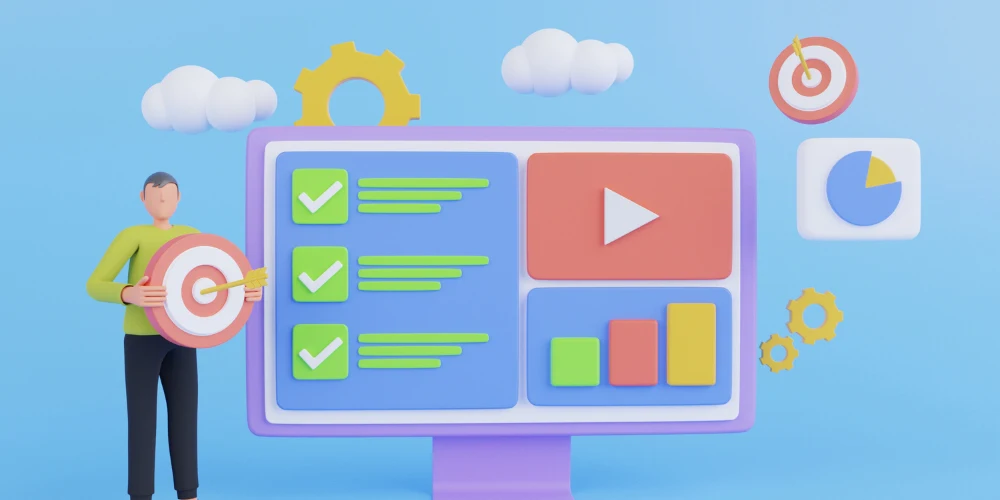Last Updated on 2 years ago by Gülenber Han
In this comprehensive guide, we will delve into the web design process and explore the key steps and essential tips that can help you create an efficient and successful website. From planning and research to design and development, we will cover everything you need to know to master the art of web design.
Understanding the Importance of Planning
Before diving into the web design process, it is crucial to understand the importance of proper planning. Strategic planning is a key factor that can greatly impact the overall success of your website and ensure that it aligns with your goals and target audience.
When it comes to web design, planning serves as the foundation upon which the entire project is built. It allows you to carefully consider your objectives, define the scope of your website, and outline the steps needed to achieve your desired outcome. Planning not only helps you stay organized throughout the process but also saves time and resources in the long run.
The Role of Planning in the Web Design Process
Planning plays a critical role in every stage of the web design process. It allows you to:
- Set Clear Goals and Objectives: By defining your goals, you can determine what you want to accomplish with your website. Whether it’s to generate leads, increase conversions, or establish your brand’s online presence, having clear objectives helps guide the design and development process.
- Identify Your Target Audience: Planning enables you to research and understand your target audience, their needs, and preferences. This information is crucial in creating a website that resonates with your visitors and provides a positive user experience.
- Establish a Seamless User Journey: Through proper planning, you can map out the user journey on your website, ensuring that visitors can easily navigate, find information, and take desired actions. This includes considering the structure of your website, the placement of key elements, and the flow of information.
- Define Functional Requirements: Planning allows you to identify the necessary functionality and features required for your website. This includes elements such as contact forms, e-commerce capabilities, content management systems, and integrations with other platforms or tools.
- Create a Cohesive Visual Design: With a well-thought-out plan, you can establish a consistent and cohesive visual design for your website. This encompasses color palettes, typography choices, imagery, and overall brand identity, ensuring a visually appealing and user-friendly experience.
- Ensure Scalability and Flexibility: Proper planning helps future-proof your website by considering scalability and flexibility. By anticipating future growth or changes, you can design and build a website that can easily adapt and evolve as your business or industry evolves.
By prioritizing the planning phase in your web design process, you can set yourself up for success and save time and resources in the long run. Remember, a well-executed plan paves the way for a well-designed and successful website that meets both your business objectives and the needs of your target audience.
Conducting Thorough Research

Research plays a crucial role in the web design process. By conducting thorough research, you can gather valuable insights and data that inform the design decisions for your website. Let’s explore the different types of research that should be conducted to ensure a successful web design:
- Competitor Analysis: Analyzing your competitors’ websites allows you to identify their strengths, weaknesses, and unique selling points. This research helps you differentiate your website and create a competitive edge.
- User Research: Understanding your target audience’s preferences, behaviors, and goals is essential for designing a user-centric website. Conduct surveys, interviews, and usability tests to gather insights that inform your design choices.
- Market Trends: Staying up-to-date with the latest industry trends and technological advancements is crucial. Research market trends to discover new design techniques, features, and functionalities that can enhance the user experience on your website.
By conducting thorough research, you can uncover valuable information that guides the entire web design process from planning and wireframing to design and development. Integrating these insights into your web design strategy ensures that your website effectively meets the needs and expectations of your target users.
Defining User Experience (UX) and User Interface (UI)
User experience (UX) and user interface (UI) are integral components of a successful web design process. When it comes to creating a website that engages and delights users, an exceptional UX/UI design is essential. Understanding the importance of UX/UI and implementing effective strategies can significantly enhance the overall user experience.
User experience refers to the overall experience that users have when interacting with a website. It encompasses various aspects, including ease of navigation, intuitive design, and seamless interactions. By prioritizing user experience in your web design process, you can ensure that your website is not only visually appealing but also user-friendly and easy to navigate.
User interface focuses on the visual elements and interactive components of a website. It involves the design of buttons, menus, forms, and other elements that users interact with. A well-designed user interface can make a website visually engaging and enhance the overall usability and accessibility of the site. To create a user-centric web design, consider the following tips:
- Intuitive Navigation: Ensure that your website’s navigation is clear, straightforward, and easy to use. Organize content logically and provide clear labels and menu structures that help users find information effortlessly.
- Visually Appealing Layouts: Design visually appealing layouts that are aesthetically pleasing and aligned with your brand. Utilize appropriate color schemes, typography, and imagery to create a visually cohesive and engaging experience for users.
- Engaging Interactions: Incorporate interactive elements such as animations, transitions, and micro-interactions to engage users and provide feedback. These interactions can guide users through the website and create a more immersive user experience.
A seamless user experience and a visually appealing user interface are crucial for attracting and retaining users on your website. By implementing these UX/UI strategies in your web design process, you can create a website that not only meets your business goals but also provides an enjoyable and meaningful experience for your users.
Creating an Effective Information Architecture
When it comes to web design, information architecture is a crucial component that can greatly enhance the user experience. By organizing and structuring content in a logical and user-friendly manner, you can ensure that visitors can easily navigate and find the information they are looking for on your website.
One of the best practices in creating an effective information architecture is the use of navigation menus. These menus serve as a roadmap for users, allowing them to quickly access different sections or pages of your site. By categorizing your content and using clear labels, you can make it easier for users to understand and follow the structure of your website. Additionally, incorporating breadcrumbs can provide users with a clear trail of their navigation path, helping them retrace their steps and easily move between different levels of your website.
Another useful tool in information architecture is the implementation of site maps. A site map provides an overview of the entire website structure, displaying all the pages and their hierarchical relationships. This visual representation can aid users in understanding the organization of your site and finding specific pages more efficiently.
Remember, a well-designed information architecture not only enhances user experience but also contributes to improved search engine optimization (SEO). Search engines like Google value websites with clear and logical structures, making it easier for their algorithms to crawl and index your content. By following the best practices in information architecture, you can optimize your website’s visibility and attract more organic traffic. Key points to consider when creating an effective information architecture:
- Use navigation menus to categorize and label your content.
- Implement breadcrumbs to help users track their navigation path.
- Create a site map to provide a clear overview of your website structure.
- Optimize your information architecture to improve search engine visibility.
By implementing these strategies, you can ensure that your website’s information architecture is well-organized, user-friendly, and optimized for both users and search engines.
Designing for Mobile Responsiveness

With the increasing use of mobile devices, designing for mobile responsiveness has become a crucial aspect of the web design process. Today, more users access the internet through their smartphones and tablets, necessitating the need for websites that adapt seamlessly to different screen sizes.
Mobile responsiveness refers to the ability of a website to adapt and provide an optimal user experience across various devices. It requires careful consideration of design elements and implementation of responsive design techniques to ensure that your website looks and functions flawlessly on mobile devices. By prioritizing mobile responsiveness, you can cater to a wider audience and improve user engagement.
One of the key techniques in designing for mobile responsiveness is the use of media queries. Media queries allow you to apply different CSS styles based on the characteristics of the device or screen size. By adjusting the layout, font sizes, and other design elements, your website can provide a seamless experience for users on both desktop and mobile devices.
Flexible grids are another important aspect of mobile responsiveness. By using flexible grid systems, you can create layouts that automatically adjust and reflow to fit different screen sizes. This ensures that your content remains readable and well-organized, regardless of the device being used. Key Tips for Designing Mobile Responsive Websites:
- Optimize typography and font sizes for readability on smaller screens.
- Ensure that buttons and interactive elements are large enough for easy tapping on touchscreen devices.
- Minimize the use of large images or videos that may affect loading times on mobile networks.
- Consider the placement of important content and navigation elements to ensure easy access on smaller screens.
- Use responsive images that adapt to the size of the device.
By implementing these techniques and following best practices, you can create a website that provides a seamless and engaging experience for users on all devices. Designing for mobile responsiveness is not only essential for improving user experience, but it is also a critical factor in achieving higher search engine rankings and driving organic traffic to your website.
Implementing Engaging Visual Design
Visual design is a fundamental aspect of a successful web design process. It is the art of capturing users’ attention and conveying your brand message through aesthetically pleasing elements. By implementing effective visual design principles, you can create web designs that not only look visually appealing but also engage and resonate with your target audience.
The Key Principles of Effective Visual Design
When it comes to visual design, there are several key principles that you should consider:
- Typography: Choosing the right fonts can significantly impact the readability and overall aesthetic of your website. Select typography that aligns with your brand persona and ensures ease of reading.
- Color Schemes: Colors can evoke emotions and set the tone for your website. Develop a cohesive color scheme that is consistent with your brand identity and conveys the desired message to your audience.
- Imagery: Selecting high-quality and relevant images can enhance the visual appeal of your website. Use images that resonate with your target audience and reflect the purpose and values of your brand.
- Use of White Space: White space, also known as negative space, refers to the empty space between elements on a webpage. Proper use of white space can improve readability and create a clean and organized design.
By integrating these principles into your visual design, you can create a captivating and cohesive website that leaves a lasting impression on your visitors.
Visual design is not only about making your website visually appealing; it also plays a vital role in improving usability and user experience. An intuitive and visually attractive design can guide users through your website effortlessly and encourage engagement and conversions. When visual design is implemented effectively, it can enhance the overall user experience and contribute to the success of your website.
Developing a Functional Website
Web development is a crucial step in the web design process, as it transforms your design into a fully functional website. From coding to testing, this section will guide you through the key steps involved in developing a functional website that works seamlessly across different browsers and devices.
Coding Languages: A fundamental aspect of web development is choosing the right coding languages to bring your design to life. HTML, CSS, and JavaScript are commonly used languages that provide the foundation for creating interactive and dynamic web pages.
Content Management Systems (CMS): Implementing a CMS simplifies website management. Popular CMS options include WordPress, Joomla, and Drupal. These platforms offer user-friendly interfaces, allowing you to update content, manage media files, and customize your website without the need for extensive coding knowledge.
Testing Strategies: Thorough testing is essential to ensure that your website functions optimally. This involves checking for browser compatibility, responsiveness across different devices, and proper functionality of interactive elements. Additionally, performing usability tests allows you to gather feedback and identify areas for improvement.
Key Steps in Web Development:
- Convert Design to HTML/CSS: Begin by implementing the visual elements of your design using HTML and CSS. This process involves translating graphical mockups into code, ensuring that the design is responsive and compatible with various screen sizes.
- Integrate Functionality: Once the visual elements are in place, incorporate interactive features using JavaScript or other scripting languages. This includes implementing navigation menus, forms, image sliders, and other dynamic elements that enhance user experience.
- Create Backend Functionality: Develop the server-side functionality that enables dynamic content and database management. This involves integrating server-side scripting languages such as PHP or Python to handle data processing, user authentication, and content retrieval.
- Optimize Performance: Ensure that your website loads quickly and performs efficiently by minimizing file sizes, optimizing images, and employing caching techniques. A high-performing website enhances user experience and contributes to better search engine rankings.
- Implement Security Measures: Protect your website from potential vulnerabilities and cyber threats by implementing security measures. This includes using secure coding practices, installing SSL certificates, and regularly updating and patching software.
By following these key steps and incorporating effective coding practices, content management systems, and testing strategies, you can develop a functional website that provides a seamless user experience and achieves your desired goals.
Optimizing for Search Engines (SEO)

When it comes to the web design process, optimizing your website for search engines is essential for driving organic traffic and improving your online visibility. By implementing effective search engine optimization (SEO) strategies, you can ensure that your website ranks well in search engine results and reaches your target audience.There are two key aspects of SEO that you should focus on: on-page optimization and off-page optimization.
On-Page Optimization
On-page optimization refers to the various techniques that you can apply directly to your website to improve its search engine rankings. These techniques include:
- Keyword Research: Conduct thorough keyword research to identify the terms and phrases your audience is searching for. Incorporate these keywords naturally into your website content, titles, headings, and meta tags.
- Meta Tags: Optimize your meta tags, including the meta title, meta description, and meta keywords, to accurately describe the content of each webpage. These tags provide search engines with valuable information about your website.
- Meta Tag Optimization: Optimize your website’s loading speed by minimizing file sizes, compressing images, and leveraging browser caching. A fast-loading website improves user experience and can positively impact your search engine rankings.
Off-Page Optimization
In addition to on-page optimization, off-page optimization focuses on external factors that can influence your website’s search engine rankings. Here are some off-page optimization techniques you should consider:
- Link Building: Build high-quality backlinks from reputable websites to increase your website’s authority and credibility. This can be achieved through guest blogging, influencer collaborations, and partnering with industry-related websites.
- Social Media Mentions: Engage with your audience on social media platforms and encourage shares, likes, and mentions. Social signals can contribute to search engine rankings and increase your website’s visibility.
- Online Directories: Submit your website to relevant online directories to improve your online presence and increase the chances of being found by search engines.
By implementing both on-page and off-page optimization techniques, you can significantly improve your website’s search engine rankings, increase organic traffic, and ultimately drive more conversions and success for your business.
Launching, Monitoring, and Continuous Improvement
Once your website is live, the web design process doesn’t come to an end. In fact, it is just the beginning of a continuous journey towards success. It is crucial to monitor your website’s performance to ensure it meets your expectations and delivers a seamless user experience.
By analyzing user behavior through robust analytics tools, you can gain valuable insights into how users interact with your website. This data-driven approach allows you to identify areas of improvement and make informed decisions to enhance user satisfaction and engagement.
Implementing continuous improvements based on user feedback and data insights is vital for staying ahead in today’s dynamic digital landscape. Regularly updating your website with fresh content, refining its design and functionality, and staying updated on industry trends will help you maintain relevance and drive ongoing success.
Remember, your website launch is just the first step in a long-term web design process. By continuously monitoring and improving your website, you can ensure it remains user-friendly, visually appealing, and aligned with your business goals.












